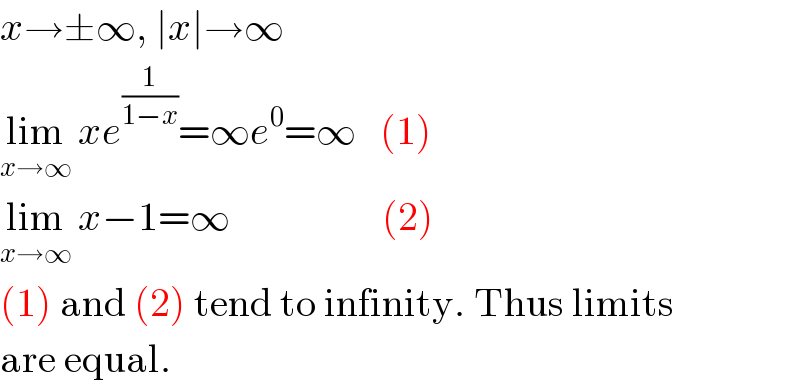
Question Number 4281 by Filup last updated on 07/Jan/16

$$\mathrm{The}\:\mathrm{following}\:\mathrm{image}\:\mathrm{shows}\:\mathrm{the}\:\mathrm{functiond} \\ $$$${f}\left({x}\right)={xe}^{\frac{\mathrm{1}}{\mathrm{1}−{x}}} \:\:\:\:\:\:\:\:\mathrm{and}\:\:\:\:\:\:{g}\left({x}\right)={x}−\mathrm{1} \\ $$$$ \\ $$$$\mathrm{Can}\:\mathrm{you}\:\mathrm{explain}\:\mathrm{as}\:\mathrm{to}\:\mathrm{why}\:\mathrm{as}\:\mid{f}\left({x}\right)\mid\rightarrow\infty, \\ $$$$\mathrm{that}\:{f}\left({x}\right)\rightarrow{g}\left({x}\right). \\ $$
Commented by Filup last updated on 07/Jan/16

Commented by Filup last updated on 07/Jan/16

$${x}\rightarrow\pm\infty,\:\mid{x}\mid\rightarrow\infty \\ $$$$\underset{{x}\rightarrow\infty} {\mathrm{lim}}\:{xe}^{\frac{\mathrm{1}}{\mathrm{1}−{x}}} =\infty{e}^{\mathrm{0}} =\infty\:\:\:\left(\mathrm{1}\right) \\ $$$$\underset{{x}\rightarrow\infty} {\mathrm{lim}}\:{x}−\mathrm{1}=\infty\:\:\:\:\:\:\:\:\:\:\:\:\:\:\:\:\:\:\:\left(\mathrm{2}\right) \\ $$$$\left(\mathrm{1}\right)\:\mathrm{and}\:\left(\mathrm{2}\right)\:\mathrm{tend}\:\mathrm{to}\:\mathrm{infinity}.\:\mathrm{Thus}\:\mathrm{limits} \\ $$$$\mathrm{are}\:\mathrm{equal}. \\ $$
Commented by Yozzii last updated on 07/Jan/16

$${f}\left({x}\right)={xe}^{\frac{\mathrm{1}}{\mathrm{1}−{x}}} \:\:\:\:\left({x}\neq\mathrm{1}\right) \\ $$$${f}^{'} \left({x}\right)={e}^{\left(\mathrm{1}−{x}\right)^{−\mathrm{1}} } +{x}×\left(\mathrm{1}−{x}\right)^{−\mathrm{2}} {e}^{\left(\mathrm{1}−{x}\right)^{−\mathrm{1}} } \\ $$$${f}^{'} \left({x}\right)={e}^{\frac{\mathrm{1}}{\mathrm{1}−{x}}} \left(\mathrm{1}+\frac{{x}}{\left({x}−\mathrm{1}\right)^{\mathrm{2}} }\right) \\ $$$${f}^{'} \left({x}\right)={e}^{\left(\mathrm{1}−{x}\right)^{−\mathrm{1}} } \left(\frac{{x}^{\mathrm{2}} −{x}+\mathrm{1}}{{x}^{\mathrm{2}} −\mathrm{2}{x}+\mathrm{1}}\right) \\ $$$${f}^{'} \left({x}\right)={e}^{\left(\mathrm{1}−{x}\right)^{−\mathrm{1}} } \left(\frac{\mathrm{1}−\frac{\mathrm{1}}{{x}}+\frac{\mathrm{1}}{{x}^{\mathrm{2}} }}{\mathrm{1}−\frac{\mathrm{2}}{{x}}+\frac{\mathrm{1}}{{x}^{\mathrm{2}} }}\right) \\ $$$$\therefore\:{l}=\underset{{x}\rightarrow\infty} {\mathrm{lim}}{f}^{'} \left({x}\right)=\underset{{x}\rightarrow\infty} {\mathrm{lim}}\left\{{e}^{\frac{\mathrm{1}}{\mathrm{1}−{x}}} \left(\frac{\mathrm{1}−\frac{\mathrm{1}}{{x}}+\frac{\mathrm{1}}{{x}^{\mathrm{2}} }}{\mathrm{1}−\frac{\mathrm{2}}{{x}}+\frac{\mathrm{1}}{{x}^{\mathrm{2}} }}\right)\right\} \\ $$$${l}={e}^{\frac{\mathrm{1}}{−\infty}} \frac{\mathrm{1}−\mathrm{0}+\mathrm{0}}{\mathrm{1}−\mathrm{0}+\mathrm{0}}=\mathrm{1}={g}^{'} \left({x}\right)\:{for}\:{x}>\mathrm{1}. \\ $$$${So},\:{the}\:{graph}\:{of}\:{f}\left({x}\right)\:{is}\:{approximately} \\ $$$${parallel}\:{to}\:{that}\:{of}\:{g}\left({x}\right)\:{for}\:{sufficiently} \\ $$$${large}\:{values}\:{of}\:{x}. \\ $$$${lnf}\left({x}\right)={lnx}+\frac{\mathrm{1}}{\mathrm{1}−{x}} \\ $$$$\therefore\underset{{x}\rightarrow\mathrm{1}^{+} } {\mathrm{lim}}{lnf}\left({x}\right)={ln}\mathrm{1}−\infty=−\infty \\ $$$$\therefore\:\underset{{x}\rightarrow\mathrm{1}^{+} } {\mathrm{lim}}{f}\left({x}\right)={e}^{−\infty} =\mathrm{0} \\ $$$${So},\:{x}=\mathrm{1}\:{is}\:{the}\:{approximate}\:{root}\:{of}\:{f}\left({x}\right)=\mathrm{0}. \\ $$$${Also},\:\underset{{x}\rightarrow\infty} {\mathrm{lim}}{lnf}\left({x}\right)=\infty\Rightarrow{f}\left({x}\right)\rightarrow\infty \\ $$$${while}\:{f}'\left({x}\right)\rightarrow\mathrm{1}.\:{So},\:{a}\:{straight}\:{line}\: \\ $$$${approximates}\:{f}\left({x}\right)\:{for}\:{large}\:{x}. \\ $$$${Given}\:{that}\:{f}^{'} \left({x}\right)\rightarrow\mathrm{1}\:{as}\:{x}\rightarrow\infty\:\:{for}\:{x}>\mathrm{1} \\ $$$${and}\:{x}=\mathrm{1}\:{is}\:{a}\:{root}\:{of}\:{f}\left({x}\right)=\mathrm{0},\:{an}\: \\ $$$${asymptote}\:{to}\:{f}\left({x}\right)\:{as}\:{x}\rightarrow\infty\:{is}\:{found}\:{to} \\ $$$${be}\:{y}−\mathrm{0}=\left(\mathrm{1}\right)\left({x}−\mathrm{1}\right)\Rightarrow{y}={x}−\mathrm{1}\:{which} \\ $$$${is}\:{the}\:{function}\:{g}\left({x}\right).\:\: \\ $$$$ \\ $$$$ \\ $$$$ \\ $$$$ \\ $$$$ \\ $$$$ \\ $$$$ \\ $$
